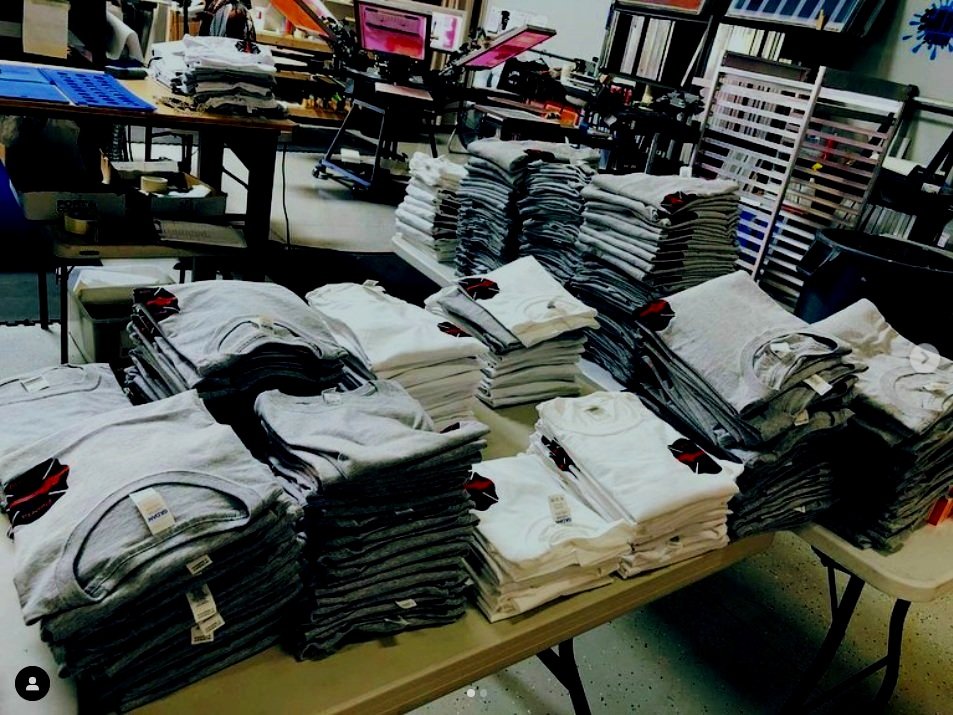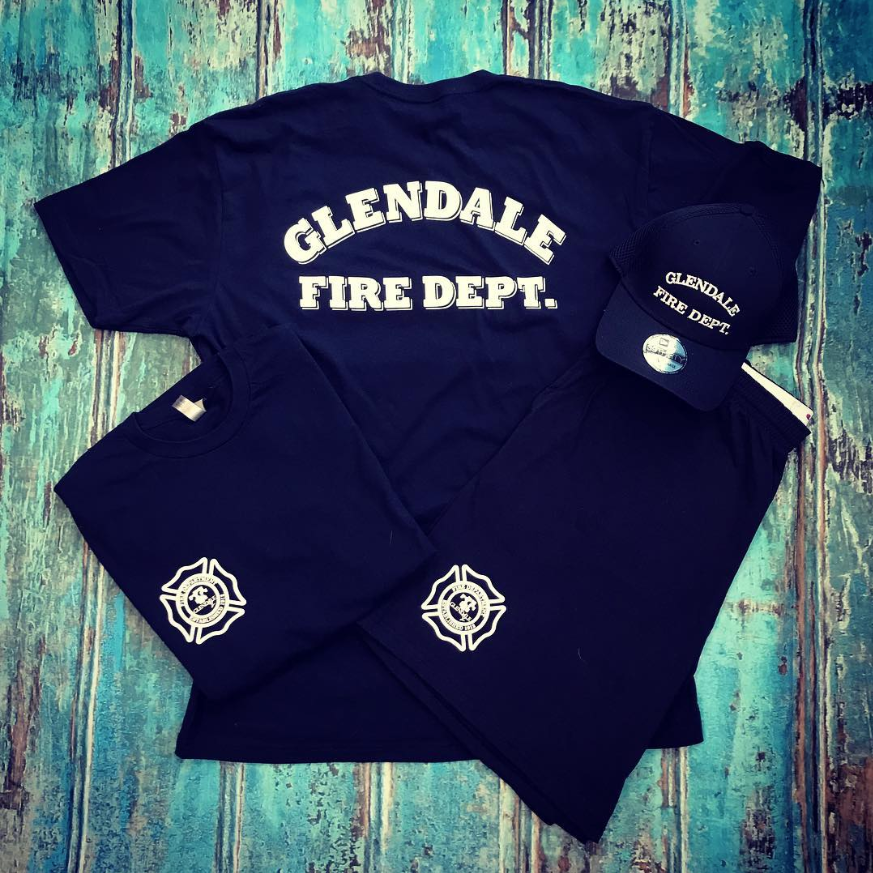Services Provided
-
Custom screen printing is a versatile and popular printing technique used to transfer ink onto various surfaces, including fabric, paper, glass, and plastics. It involves creating a stencil on a mesh screen, with the desired design or pattern, and then pressing ink through the mesh onto the printing surface using a squeegee. The areas of the screen without the stencil block the ink, allowing precise and repeatable prints. Screen printing is commonly used for t-shirt and apparel printing, as well as for creating posters, banners, and other promotional materials. Its ability to produce vibrant and durable prints makes it a favored choice for many commercial and artistic applications.
-
Embroidery for garments and clothing involves the art of stitching designs or patterns onto fabric using specialized machines or hand techniques. The process starts with digitizing the design, converting it into a digital embroidery file compatible with the machines. The chosen fabric is then hooped securely in the embroidery machine, and the needle follows the digitized pattern to create the design with colored threads. Embroidery offers a textured and long-lasting finish, making it ideal for adding logos, monograms, or decorative elements to various apparel items such as shirts, hats, jackets, and accessories. It is a popular choice for personalized and branded clothing, adding a touch of sophistication and uniqueness to the garments. Visit our custom embroidery page for more information.
-
Heat transfers for garments and accessories involve applying designs or graphics to the surface of fabrics using heat and pressure. The process starts with printing the desired design onto a special transfer paper using sublimation or inkjet printing. The transfer paper is then placed face down onto the fabric, and heat is applied using a heat press machine. The combination of heat and pressure causes the ink on the paper to transfer and adhere to the fabric, creating a permanent and vibrant image. Heat transfers are commonly used for t-shirts, hats, bags, and other accessories, providing a cost-effective and efficient way to produce custom designs with high-quality results.
-
Corporate promotional products are branded items that companies use as part of their marketing and advertising strategies. These products are typically given away as freebies or gifts to customers, clients, employees, or prospects to increase brand visibility and loyalty. Common corporate promotional products include items like pens, notepads, keychains, mugs, USB drives, t-shirts, tote bags, and more. The products are customized with the company's logo, name, or message, creating a lasting impression and fostering a positive association with the brand. These promotional products serve as tangible reminders of the company and its offerings, helping to enhance brand recognition and engagement.
Testimonials

Providing Professional Screen Printing and Promotional Products for Over a Decade!
What We Need to Get Started
Type of service (shirts, hats, mugs, etc.)
Artwork file (logos, graphics, etc.)
Type (s) of garment - shirts, polos, hoodies, hats, etc.
Quantity and sizes
Location of decoration (front, back, sleeve, etc.)
Shipping or pick-up













Schedule a Call Today!
We’ll are excited to hear about your need for screen printing, embroidery, and promotional products!

Custom Screen Printing - Phoenix, AZ
Screen printing a t-shirt at Athletic Ink, a professional screen printing company involves a well-organized and systematic process. Here are the detailed steps we take for every order and every client:
Step 1: Design Consultation and Preparation
The process starts with a design consultation where the client discusses their design requirements with the screen printing company. The company's design team may assist the client in refining or optimizing the artwork for screen printing.
Once the design is finalized, it is converted into a high-resolution digital file, which will be used to create the screen stencils.
Step 2: Screen Preparation
The screen printing company selects the appropriate screen frames for the design. Each color in the design requires a separate screen. The screens are coated with a layer of photosensitive emulsion. The emulsion is applied to the screen using a scoop coater to create an even and consistent layer. The screens are then left to dry in a dark and dust-free environment.
Step 3: Film Positives and Screen Exposure
The finalized design is printed onto transparent film positives. Each film positively corresponds to a separate color in the design. The dried screens are paired with the film positives. The film positives are placed on top of the screens, and they are held together with a vacuum or tight-fitting glass frame to ensure they stay in position during exposure.
The screens and film positives are exposed to a high-intensity UV light source or a screen exposure unit. The light hardens the emulsion in the areas exposed through the transparent parts of the film, creating a stencil on each screen.
Step 4: Screen Setup and Registration
The screens are carefully washed and developed to remove the unexposed emulsion, revealing the stencil. The screens are then mounted onto the screen printing press. Each screen is aligned precisely to ensure accurate registration, meaning that all the colors in the design align correctly when printed onto the t-shirt.
Step 5: Ink Preparation and Testing
The screen printing company prepares the ink for each color in the design. They mix the ink to match the client's specified colors accurately. Test prints are made on sample fabric to check the color accuracy, print quality, and adjust the ink consistency if needed.
Step 6: T-Shirt Setup
The t-shirts are loaded onto the screen printing press. Each t-shirt is positioned consistently to ensure accurate and uniform printing. A layer of adhesive or spray tack is applied to the printing surface to hold the t-shirt in place during printing.
Step 7: Printing
The actual printing process begins. The ink is poured onto the top side of the screen for the first color. The screen is lowered onto the t-shirt, and a squeegee is used to press the ink through the mesh and onto the fabric. The squeegee is pulled with firm and consistent pressure to ensure even coverage.
The process is repeated for each color in the design, with each color requiring a separate pass with a different screen.
Step 8: Curing
Once all the colors are printed, the t-shirts are moved to a conveyor dryer or a heat press for curing. The curing process ensures that the ink bonds permanently with the fabric and becomes wash-fast. The t-shirts pass through the dryer or heat press at the appropriate temperature and time to cure the ink thoroughly.
Step 9: Quality Control and Finishing
The printed t-shirts undergo a quality control check to ensure that each print meets the desired standard of color, registration, and overall quality. Any necessary touch-ups or corrections are made at this stage.
Once the printing and curing process is complete, the t-shirts are folded, tagged, and packed according to the client's specifications.
Step 10: Delivery or Distribution
The finished and packed t-shirts are ready for delivery to the client or for distribution, depending on the client's requirements.
Throughout the entire process, professional screen printing companies maintain strict quality control measures to ensure the highest level of consistency and accuracy in their prints, meeting the expectations and demands of their clients.
Schedule a Call Today!
We’ll are excited to hear about your need for screen printing, embroidery, and promotional products!



